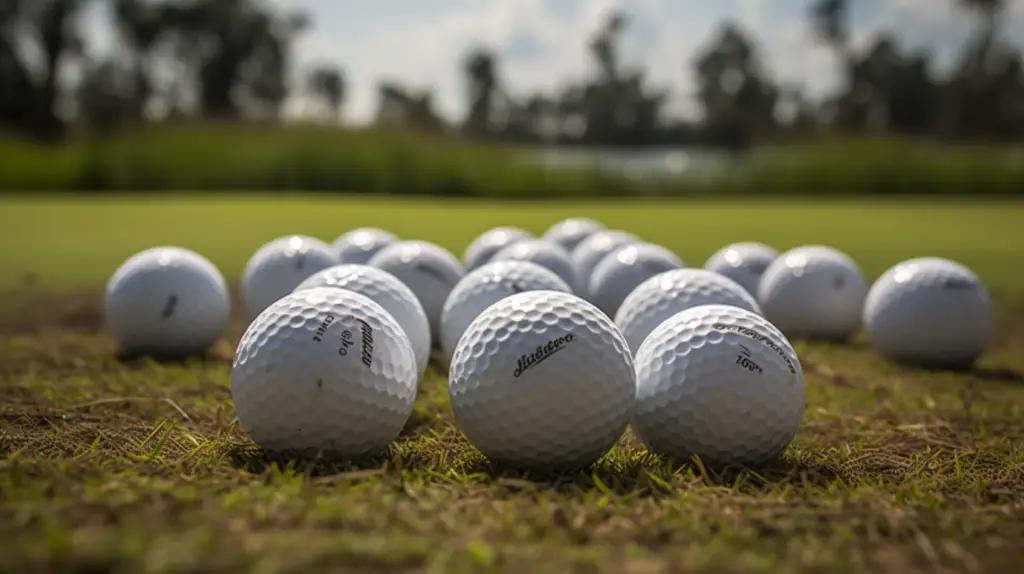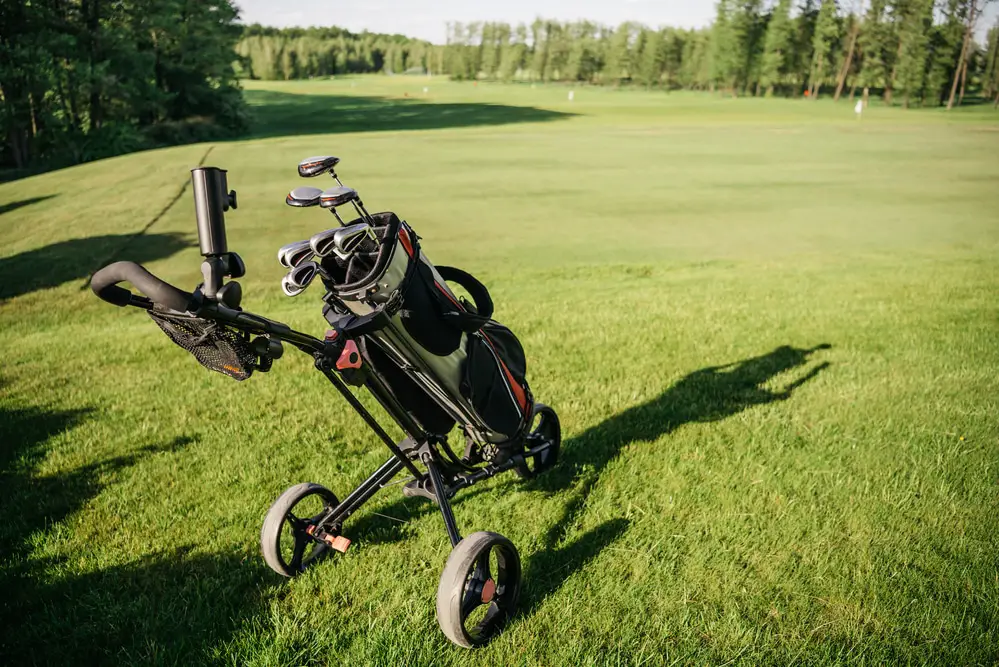Last Updated on November 10, 2023
Golf is a sport that has been enjoyed by individuals for centuries and continues to be popular today. The type of golf ball used can have an impact on the outcome of each shot, making it important for players to consider their choice carefully. One factor that should be taken into account when selecting a golf ball is compression – the amount of force required to compress the core material inside the ball. This article will explore what compression golf balls are available on the market and discuss which one may be most suitable for different types of players.
Overview of Golf Ball Compression
Golf ball compression is an important factor to consider when selecting a golf ball. Compression ratings measure the hardness of the core and indicate how much energy from the clubface will be transferred into the distance off the tee. These ratings are usually found on the packaging of new golf balls, ranging from 80-110 in terms of units per square inch (psi). Lower compression ratings often result in greater distance, while higher compression ratings tend to provide more control over shots.
The effects of compression vary depending on swing speed; generally speaking, players with slower swing speeds benefit from using lower compression balls as these require less power for maximum performance. Players with higher swing speeds should choose a ball with a higher compression rating due to their ability to generate more force at impact. It is also important to note that different materials used in golf balls allow for varying degrees of feel and spin regardless of compression rating.
Understanding Spin and Distance
When selecting a golf ball, it is important to consider spin and distance control. The compression rating of a golf ball directly impacts both spin and distance; the higher the compression, the more energy is transferred at impact resulting in greater distances but less spin control. Lower compression ratings result in improved spin control with slightly reduced distances.
To optimise performance on the course, one should consider these factors when choosing an appropriate compression rating:
- Spin Control: Higher compression balls require more precise swing mechanics for optimal trajectory, while lower compression offers better spin control even if hit off-centre.
- Distance Control: Low compression yields shorter distances due to decreased energy transfer, whereas high compression allows for increased launch angles and thus reaches farther targets.
- Feel: It is also important to note that different players might prefer different feels from their equipment, so trying out various options may be necessary to determine which type suits them best.
- Swing Speed: Finally, understanding your individual swing speed will help you make an educated choice about what type of ball provides ideal results. Players with slower swings generally benefit from low compression models as they will yield maximum trajectories without sacrificing accuracy or feel.
By considering all four aspects listed above, one can ensure they are making an informed decision when choosing a golf ball that matches their playing style and preferences in order to maximise performance on the course.
Different Types of Golf Balls
Golf balls are categorised based on their material construction, compression rating and core. The most common type of golf ball is a two-piece design consisting of a durable cover and an inner layer for extra durability and added distance. Three-piece designs have a softer core surrounded by multiple layers to generate more control off the tee. Four-piece models typically feature an even larger soft core with additional layers providing increased spin performance around the green. Compression ratings indicate energy transfer from the club head to the ball during impact. Golf balls with higher compression ratings generally produce greater distances, while those with lower compression ratings provide enhanced feel and spin control. Understanding your own game will help you decide which golf ball best suits your needs in terms of construction type, compression rating, and other features such as dimple pattern or aerodynamics technology. Ultimately, selecting the right golf ball can make all the difference in improving your score on the course.
Low Handicap Players
Low handicap players typically have higher swing speeds and require a golf ball that provides them with control as well as distance. Compression golf balls are designed to help reduce spin, thus allowing the golfer to achieve greater distances from their shots without sacrificing accuracy. Low-handicap players should look for compression golf balls that provide maximum energy transfer, which helps propel the ball further down the fairway without compromising its flight trajectory or spin rates. Generally speaking, these types of golf balls can be identified by low compression ratings (under 80) and soft cores. Additionally, they usually feature urethane covers that allow for an enhanced feel around the greens while still providing adequate durability over time. Ultimately, choosing a suitable compression golf ball will depend on an individual’s ability level and desired performance outcomes when it comes to ball speed and potential carry distances.
Mid Handicap Players
Mid-handicap players are those who have a handicap ranging from 10 to 20. When selecting golf balls for this group, it is important to consider distance control and ball selection. Golfers with mid-handicap should focus on finding a compression golf ball that offers maximum distance off the tee while still providing optimal spin around the greens. The ideal ball for this type of player will provide them with enough carry to hit longer shots but also enough control to ensure accuracy when playing shorter approaches.
It is also recommended that mid-handicap players opt for more durable golf balls, such as three-piece or four pieces models, which can help improve overall feel and consistency while swinging throughout an entire round. This combination of increased distance and improved spin characteristics makes these types of golf balls perfect for mid-handicap players looking to take their game up a notch. With careful consideration and testing, mid-handicappers can find the right compression golf ball that will optimise performance while allowing them to maintain good course management during play.
High Handicap Players
High handicap players typically require a golf ball that offers improved distance off the tee. Distance golf balls are designed with low-compression cores and thin covers, allowing them to travel further without sacrificing durability or spin rate. For high handicappers, it is important to select a golf ball that has moderate spin rates on approach shots for better accuracy; otherwise, too much backspin can cause shots to balloon in the air and result in inaccurate distances. High handicappers should also look for a ball that provides a good feel around the greens, so they have more control when chipping and putting. A quality golf ball with mid-high compression offers superior performance from tee to green.
Equipment Maintenance Tips

Proper equipment maintenance is essential for optimal performance and extending the life of golf balls. Golf ball cleaning should be a regular part of any golfer’s routine, as dirt and debris on the surface can interfere with spin rate and trajectory. A simple solution of water and mild detergent applied with a soft cloth can effectively remove most contaminants from the cover of a golf ball without damaging it. It is also important to store golf bags in dry areas away from extreme temperatures, direct sunlight, or moisture. Storing bagged clubs vertically rather than horizontally will help keep their shafts straight over time. Additionally, using an appropriate travel bag when transporting golf clubs helps protect them against jostling or damage during transport. Finally, regularly inspecting clubs for signs of wear can help identify issues before they become costly repairs or replacements.
Frequently Asked Questions
What Is the Best Compression Golf Ball for Beginners?
When looking for the best compression golf ball for beginners, there are several factors to consider. Beginner golfers should look at the type of cover material used and the size of the core in order to optimise their performance on the course. Compression is also a key factor, as it will affect how far each shot can travel. Here are some key points to keep in mind when choosing a beginner golf ball:
- Look for balls with softer covers that produce less spin off the tee.
- Select a ball with an oversized core so you have more control over your shots.
- Choose a ball with medium compression, which allows you to get maximum distance without sacrificing accuracy or feel.
- Consider using multi-layer construction, which offers better durability while still providing good feedback during impact.
By considering these four important elements, any beginner golfer can find a suitable golf ball with an optimal level of compression to help them maximise their potential on the course.
How Much Does a Compression Golf Ball Typically Cost?
The cost of a compression golf ball is an important factor to consider when looking for the right one. Depending on the brand, quality and type, prices can range from $2 per ball to as high as $45 or more. Golfers should also take into account their own budget and skill level before making any purchase.
When shopping for a compression golf ball, it is essential to understand what determines its cost. The most obvious factors are materials used in the manufacturing process, such as rubber, plastic and foam. Additionally, higher-end balls often contain proprietary technologies that make them pricier than those without special features. Moreover, professional brands tend to be more expensive due to increased research and development costs associated with producing premium products.
In addition to material costs, buyers must also consider how often they play golf and how much wear and tear their current golf balls have endured. For example, if someone plays frequently, then investing in a set of mid-priced balls would be beneficial since they will last longer than cheaper alternatives. On the other hand, casual players may opt for lower-priced models which will meet their needs at a fraction of the cost. Ultimately, deciding on the best compression golf ball comes down to personal preference and budgeting constraints.
Conclusion
In conclusion, there are many aspects to consider when selecting a suitable compression golf ball for a beginning golfer. Taking cost into consideration is essential so that playing remains affordable and enjoyable. Likewise, being aware of any regulations regarding these types of balls in tournament play is critical before making a purchase. Also, having an understanding of different levels of compressions between soft and hard can make choosing more manageable as well as potentially aid performance on the course when tackling issues such as slicing. Ultimately, by taking each factor above into account, finding the right compression golf ball should become easier and bring much-needed enjoyment out on the fairways.


